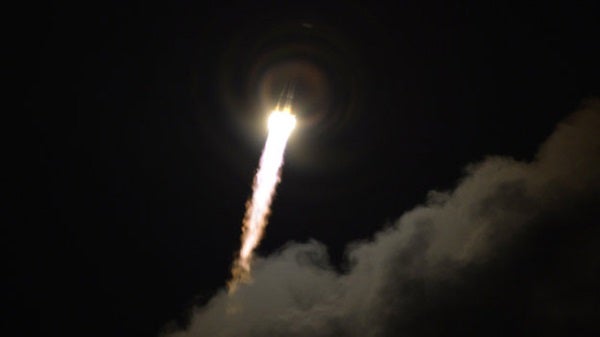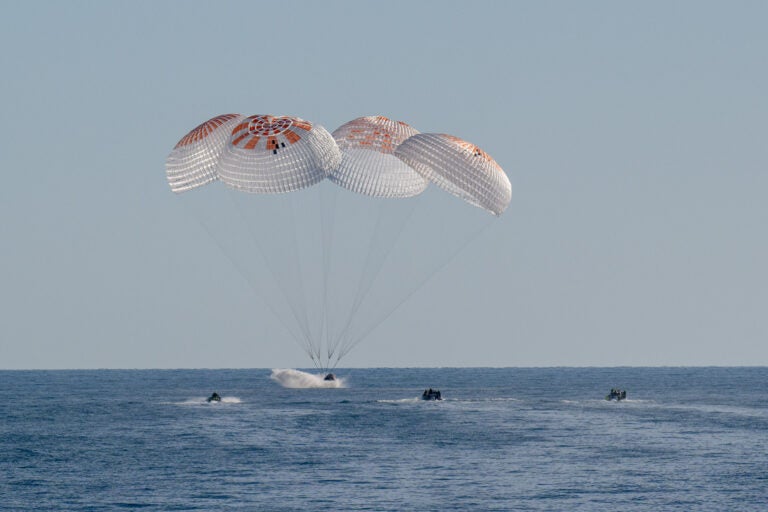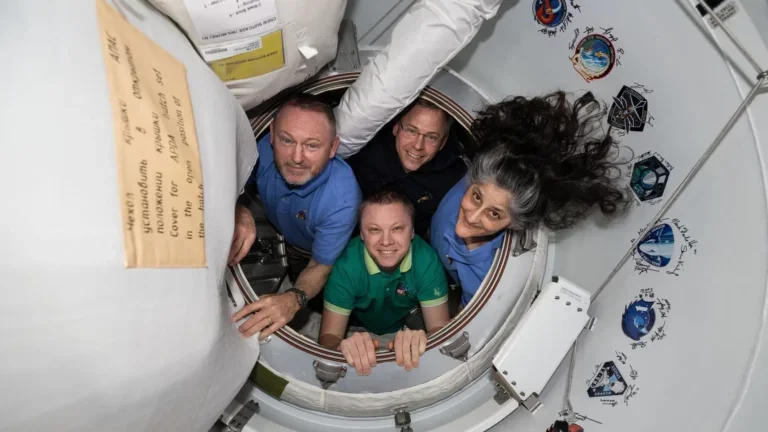Gaia is destined to create the most accurate map yet of the Milky Way. By making accurate measurements of the positions and motions of 1 percent of the total population of roughly 100 billion stars, it will answer questions about the origin and evolution of our home galaxy.
The Soyuz launcher, operated by Arianespace, lifted off at 10:12 CET. About 10 minutes later after separation of the first three stages, the Fregat upper stage ignited, delivering Gaia into a temporary parking orbit at an altitude of 110 miles (175 kilometers).
A second firing of the Fregat 11 minutes later took Gaia into its transfer orbit, followed by separation from the upper stage 42 minutes after liftoff. Ground telemetry and attitude control were established by controllers at ESA’s operations center in Darmstadt, Germany, and the spacecraft began activating its systems.
The sunshield, which keeps Gaia at its working temperature and carries solar cells to power the satellite, was deployed in a 10-minute automatic sequence, completed around 88 minutes after launch.
Gaia is now en route toward an orbit around a gravitationally stable virtual point in space called L2, some 930,000 miles (1.5 million km) beyond Earth as seen from the Sun.
Tomorrow, engineers will command Gaia to perform the first of two critical thruster firings to ensure it is on the right trajectory toward its L2 home orbit. About 20 days after launch, the second critical burn will take place, inserting it into its operational orbit around L2.
A four-month commissioning phase will start on the way to L2, during which all of the systems and instruments will be turned on, checked, and calibrated. Then Gaia will be ready to begin its five-year science mission.
Gaia’s sunshield will block heat and light from the Sun and Earth, providing the stable environment needed by its sophisticated instruments to make an extraordinarily sensitive and precise census of the Milky Way’s stars.
“Gaia promises to build on the legacy of ESA’s first star-mapping mission, Hipparcos, launched in 1989, to reveal the history of the galaxy in which we live,” said Jean-Jacques Dordain from ESA. “It is down to the expertise of Europe’s space industry and scientific community that this next-generation mission is now well and truly on its way to making ground-breaking discoveries about our Milky Way.”
Repeatedly scanning the sky, Gaia will observe each of the billion stars an average of 70 times each over the five years. It will measure the position and key physical properties of each star, including its brightness, temperature, and chemical composition.
By taking advantage of the slight change in perspective that occurs as Gaia orbits the Sun during a year, it will measure the stars’ distances and, by watching them patiently over the whole mission, their motions across the sky.
The position, motion, and properties of each star provide clues about its history, and Gaia’s huge census will allow scientists to piece together a “family tree” for our home galaxy.
The motions of the stars can be put into “rewind” to learn more about where they came from and how the Milky Way was assembled over billions of years from the merging of smaller galaxies and into “fast forward” to learn more about its ultimate fate.
“Gaia represents a dream of astronomers throughout history, right back to the pioneering observations of the ancient Greek astronomer Hipparchus, who cataloged the relative positions of around a thousand stars with only naked-eye observations and simple geometry,” said Alvaro Giménez from ESA. “Over 2,000 years later, Gaia will not only produce an unrivalled stellar census, but along the way has the potential to uncover new asteroids, planets, and dying stars.”
By comparing its repeated scans of the sky, Gaia also will discover tens of thousands of supernovae, the death cries of stars as they reach the end of their lives and explode. And slight periodic wobbles in the positions of some stars should reveal the presence of planets in orbit around them as they tug the stars from side to side.
Gaia also will uncover new asteroids in our solar system and refine the orbits of those already known, and it will make precise tests of Einstein’s famous theory of general relativity.
After five years, the data archive will exceed 1 Petabyte or 1 million Gigabytes, equivalent to about 200,000 DVD’s worth of data. The task of processing and analyzing this mountain of data will fall to the Gaia Data Processing and Analysis Consortium, composed of more than 400 individuals at scientific institutes across Europe.
“Where Hipparcos cataloged 120,000 stars, Gaia will survey almost 10,000 times as many and at roughly 40 times higher precision,” said Timo Prusti from ESA. “Along with tens of thousands of other celestial and planetary objects, this vast treasure-trove will give us a new view of our cosmic neighborhood and its history, allowing us to explore the fundamental properties of our solar system and the Milky Way and our place in the wider universe.”
“After years of hard work and determination of everyone involved in the mission, we are delighted to see our Gaia discovery machine on the road to L2, where we will continue the noble European tradition of star charting to decipher the history of the Milky Way,” said Giuseppe Sarri from ESA.










